| |
|
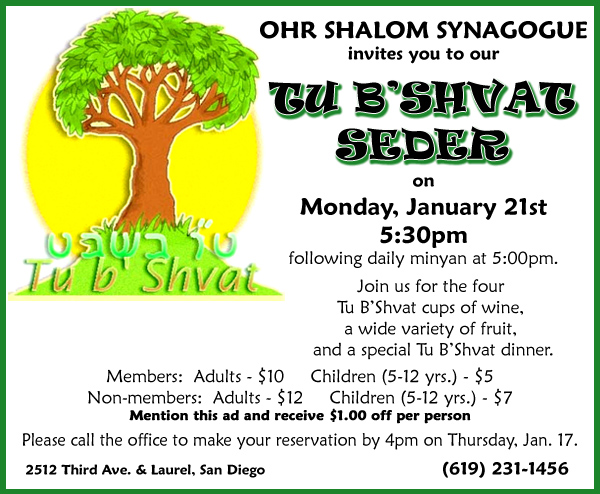

THE JEWISH CITIZEN
Citizenship ceremony speakers glamorize U.S. history; gloss over mistakes of the past
By Donald H. Harrison
 SAN DIEGO—As of yesterday, I am the proud father-in-law of two new American citizens: my daughter-in-law Hui-Wen Harrison from Taiwan and my son-in-law Shahar Masori from Israel. Hui-Wen (also known as Cathy) was sworn in yesterday at a ceremony in the Civic Center in downtown San Diego; Shahar went through the same rite at the same place in November. SAN DIEGO—As of yesterday, I am the proud father-in-law of two new American citizens: my daughter-in-law Hui-Wen Harrison from Taiwan and my son-in-law Shahar Masori from Israel. Hui-Wen (also known as Cathy) was sworn in yesterday at a ceremony in the Civic Center in downtown San Diego; Shahar went through the same rite at the same place in November.
It would have been delightful if the two of them could have been sworn in at the same time, but typical of many busy families, everyone seemed to have
Donald H. Harrison
different travel and work schedules, myself and Nancy included. So while we were unable to attend Shahar's ceremony (although our daughter Sandi, and grandsons Shor and Sky did) we were able along with our son David to observe Hui-Wen's from the balcony above. I had questioned Shahar closely after his naturalization, so I know that the proceedings yesterday were quite similar to those he had experienced in November.
An officer of the United States Citizenship and Immigration Services (USCIS) announced that all the applicants for naturalization in attendance on the ground floor of Golden Hall previously had been examined and were found to qualify for citizenship. Among the 1,208 present yesterday were 42 uniformed members of the United States Armed Forces. The official then "moved" that the immigrants be admitted into citizenship subject to their taking the oath of allegiance. An immigration court judge responded that the "motion is granted, and with that will all of you please stand so I can administer the oath of allegiance."
They did, raised their right hand, and repeated these words: "I (name), hereby declare on oath that I will absolutely and entirely renounce and abjure all allegiance and fidelity to any foreign prince, potentate, state or sovereignty of whom or which I have heretofore been a subject or citizen; that i will support and defend the Constitution and the law of the United States of America against all enemies foreign and domestic; that I will bear true faith and allegiance to the same; that I will bear arms on behalf of the United States when required by law; that I will perform non-combatant service in the Armed Forces of the United States when required by law; that I will perform work of national importance under civil direction when required by law; and that I take this obligation freely, without any mental reservation or purpose of evasion, so help me God."
The judge then congratulated the new citizens, suggesting they give themselves a round of applause. They did. She suggested that they "shake the hand of the new citizen next to you" and they did.
After having all the new citizens take their seat, the judge noted that "all of you who are here today come from different backgrounds, different religions, different culture, and all of you hopefully bring that here to the United States. That is what makes this country great. All of us have different backgrounds, different cultures and we are of different ethnic groups."
Up to that point, I was nodding my head in agreement. Then the judge added:
"And this country has opened its arms always to everyone who wants to come here ... and who wants to be a part of this country."
Oh c'mon. Always? I couldn't help thinking.
There were times in our nation's history when neither of my children-in-law would have been admitted to the United States, much less with open arms. Early in our history there were Chinese exclusion laws, which would have excluded Hui-Wen. She and our son David might never have met here, fallen in love, and married. Similarly there were laws severely restricting the entry of Jews to the United States, especially in that frantic period before and during World War II when Jews tried desperately to escape the Nazi killing machine. One still shudders at the mention of the SS St. Louis, whose Jewish passengers were turned away from port after port, before the ship eventually returned to Europe. Shahar might never have been able to come here with Sandi from Israel.
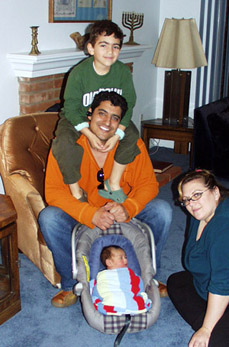 . .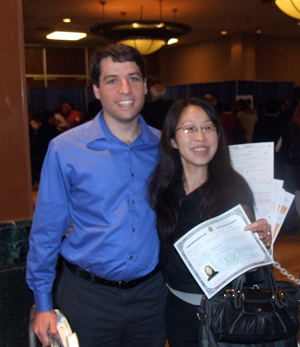
I don't mean to rain on anyone's parade, but I believe we ought to acknowledge and learn from the ugliness in our history, and be glad that we were able to surmount it. There were immigrants of more than 80 nations at yesterday's naturalization ceremony, and those from African nations must have been aware that in the times of slavery, it was not with open arms, but with closed hearts, that Americans greeted previous generations of Africans.
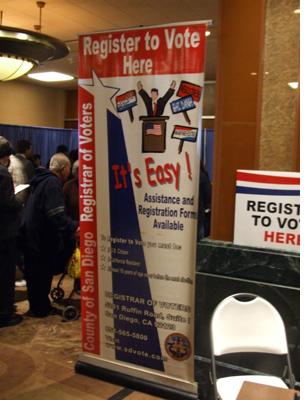 "This is a great time to become a citizen; this is an election year," the judge was continuing. "So you now have the opportunity to vote for anyone you want, not only on the national level, but on the local level. We have many people who run for office for the city, the county, the state, even your school boards, and other offices. So promise me that you will participate because that is what a citizen should do." I was back to nodding my head in agreement again. "This is a great time to become a citizen; this is an election year," the judge was continuing. "So you now have the opportunity to vote for anyone you want, not only on the national level, but on the local level. We have many people who run for office for the city, the county, the state, even your school boards, and other offices. So promise me that you will participate because that is what a citizen should do." I was back to nodding my head in agreement again.
The judge then asked for volunteers to "come up to the stage and tell us what you are feeling right now." A woman from Mexico, with a choked-up voice, said she felt "very proud to be here today." Another woman, from Argentina, said that after 16 years of various obstacles"finally we made it, and I am here. This is really a special moment for me!" And, a man from the Philippines quoted Psalm 23:5 "My cup runneth over!"
Next, the judge acknowledged the San Diego chapter of the National Society of the Daughters of the American Revolution (DAR) as the organization that served as "sponsor" of this particular naturalization class. What a long way that organization has come, I recall thinking. Back in 1939, the D.A.R. prevented black singer Marian Anderson from singing at "white-only" Constitution Hall in Washington, D.C., prompting the concert to be relocated to the Lincoln Memorial, where 75,000 people attended. But here, now, the D.A.R. was sponsoring a class of immigrants with skins of every hue. That is what I meant about acknowledging and learning from mistakes.
Joyce Lang, a regent of the DAR's San Diego chapter, told the group "our nation was founded by men and women who believed in freedom, equality, justice and humanity for all, and were willing to sacrifice their lives... for this cause."
For all? Why, I wondered, is such historical revisionism necessary? There was slavery, not freedom, for African-Americans at the time of the founding of our nation. Men were allowed to vote, but women were not. Shouldn't new citizens be told the truth, rather than myths, about our country? What purpose does romantacizing our past serve?
The ceremony continued with a roll call of the countries from which the immigrants came. On this occasion, our family waited to cheer lustily for Taiwan. The largest contingents were from Mexico and the Philippines and when those countries' names were called, Golden Hall rocked with the cheers.
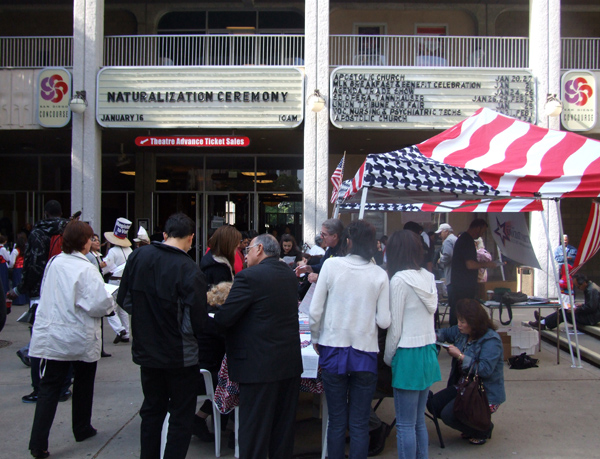
The ceremony ended with the new citizens being called by rows to receive their naturalization papers. But there was more to do. In the lobby, the U.S. Post Office staffed booths where new citizens could apply for U.S. passports. And the San Diego County Registrar of Voters had other booths inside the hall where they could register in vote in time for California's Feb. 5 primary. Outside, in the plaza of the Civic Center, the Democratic party had another booth, where the new citizens also could register to vote.
.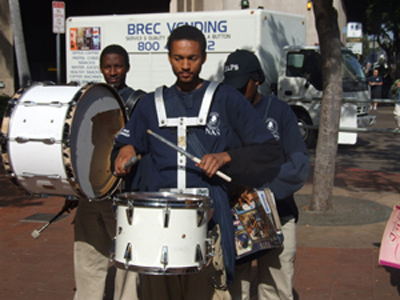 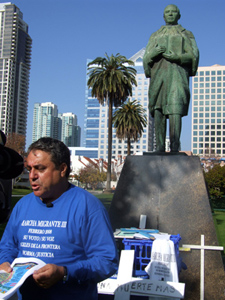
After Nancy and I bade son David and new citizen Hui-Wen goodbye, we saw two demonstrations of what American citizenship is all about. Outside City Hall, a small group was marching in support of an organization called the National Association for the Prevention of Starvation (NAPS), a predominantly African-American group that raises funds to help feed hungry people in Africa.
Less than a mile away, at Pantoja Park, which is graced by a large statue of Mexican liberator and president Benito Juarez, the head of the Border Angels organization, Enrique Morones, was holding a news conference to announce that there would be a march from San Diego to the Canadian border and back in February to call on all new citizens to register to vote and to have their voices heard in issues affecting migrants from other countries.
So it was a day of a citizenship ceremony followed by witnessing two acts of citizenship. Or perhaps this column makes it three, as critiquing our government, even its judges, is a cherished right.
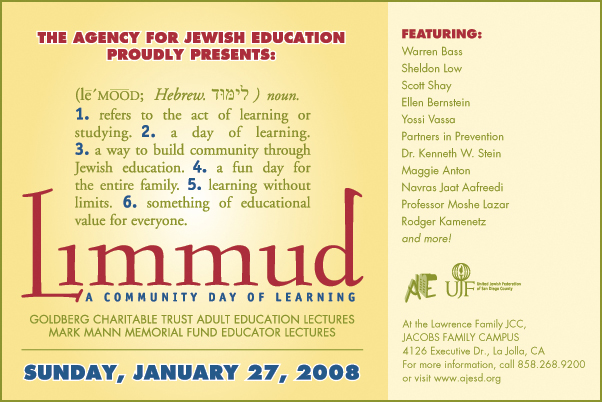



PEOPLE OF THE BOOKS
The clash of science and fundamentalism
By Fred Reiss, Ed.D
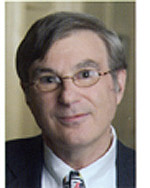 WINCHESTER, California—Can an ancient religion anticipate the findings of modern science? Henry Morris, the intellectual father of Creation Science, thinks so. He found the Law of Conservation of Energy in Ecclesiastes 3:14, which says, “I know that all that God will do will last forever. Nothing can be added or taken from it.” Of course, he fails to mention violations of the conservation laws when Joshua made the sun stand still (Joshua 10:12-13). In fact, to make the sun stand still implies that the sun is moving, and not the earth. Copernicus discredited the Geocentric Theory more than 400 years ago. WINCHESTER, California—Can an ancient religion anticipate the findings of modern science? Henry Morris, the intellectual father of Creation Science, thinks so. He found the Law of Conservation of Energy in Ecclesiastes 3:14, which says, “I know that all that God will do will last forever. Nothing can be added or taken from it.” Of course, he fails to mention violations of the conservation laws when Joshua made the sun stand still (Joshua 10:12-13). In fact, to make the sun stand still implies that the sun is moving, and not the earth. Copernicus discredited the Geocentric Theory more than 400 years ago.
Fred Reiss
Judaism, in addition to the Bible, relies on its oral tradition, known as the Talmud. The Talmud (Tractate Shabbat) says that sun signs (the Zodiac) and planets have influence over our lives. Although astrology is still a popular concept, science discredited it long ago. The Talmud (Pirke Avot) also says of the Five Books of Moses, “Turn it; turn it, for everything is in it.” Islam is no different than Judaism in this regard. The Quran is the infallible word of God – Allah. Any problems between the pronouncements of science and the Quran are due to one’s inability to properly interpret the Quran; implying that all modern science is contained therein.
Taner Edis, author of An Illusion of Harmony is a physicist and Turkish Muslim who declares himself to be an Islamic disbeliever. From this perspective, he seamlessly blends the beliefs of fundamental and liberal Islam with the findings of modern science. According to Edis, Islamic countries are doomed to remain behind the Western world without a significant shift in Muslim thinking from simply borrowers of technology to solvers of important scientific problems. To accomplish this, he says, Muslim countries must create an Islam-believing core of pure research scientists.
The International Islamic University of Malaysia reported that all countries that comprise the Organization of Islamic Conference (OIC) have less that one scientist or one engineer per 100, compared to the world averages of four and fourteen per 100 in the most advanced countries. In August 2007, the OIC noted that over the previous ten years, twenty Arab countries contributed just half the number of scientific papers that Israel contributed alone. In fact, Israel produces more scientific papers per capita, 109 per 10,000, than any other nation.
Edis tells us that Islam represents itself as a religion that is open to new knowledge; including knowledge obtained through scientific research. In reality, he asserts, this is not the case. Muslims will accept technology that offers practical solutions to everyday problems, but not, for example, Darwinism and certain types of genetic research. They are generally suspicious of pure science because science does not need Allah to describe the world.
The period from the ninth to thirteenth centuries was Islam’s Golden Age and compared to Europe, marked by superior learning and knowledge production. During this time, Muslims translated Greek works into Arabic; thereby preserving for the world the seminal work of Greek philosophers and gave the world the mathematics known as algebra, among other important scientific findings. Yet, it has been more than seven hundred years since Islam produced any significant scientific breakthrough.
Why is it that the scientific leadership of the Islamic world disintegrated and then fell so far behind the Western world? In Europe, science had little impact on religious beliefs until the Renaissance, when theology finally gave way to scholasticism. The reins of power in theocratic countries and countries with strong right-wing religious movements kept scientific investigations in check. The Catholic Church to this day still defends itself against its treatment of such thinkers as Giordano Bruno and Galileo. The fate of scientific thought is no different in the Muslim world. Today, all Islamic science must be linked to the Quran because secular governments never took hold for very long in Islamic countries.
The scientific conceptions of late-medieval Christians did not differ significantly from Jews or Muslims. They each believed that God revealed Himself to a chosen prophet and the universe operated as ordained by God/Allah. Jews lacked a theocratic government and simply rode the political waves and scientific thoughts on which the tides of history carried them. Christianity, unlike Islam, was forced to yield over time to secular authorities who disengaged themselves from the revealed word of God as they pursed glory, power, and wealth. So unlike Muslims, Christians were free to re-learn and assimilate ancient knowledge (that the Muslim world saved), as well as discover new knowledge that might not agree with church canon. Western science is secular.
According to Edis, Muslims began appreciating the military, administrative, economic, scientific, and technological advances of the Western world more than a hundred years ago. Nonetheless, science and rationalism lag in Islamic countries (or any country for that matter) with strong ecclesial leadership. There are both fundamentalist and liberal-thinking elements in all Islamic countries. Orthodox Muslims use the Quran to find science. They quote the Quran, for example, which says that “God creates you inside your mothers, in successive formations, in three darknesses” to prove that the Quran preceded our scientific understanding of embryonic development. However, these Muslim fundamentalists do not mention that Aristotle, preceding the Quran by more than a thousand years, describes these very stages in the development of a chick embryo. In contrast, Islamic liberals believe that science is a practical endeavor that must be accommodated by Islam, and not necessarily found in the Quran.
Edis explains that quantum mechanics, the physics and the atom and subatomic world in which probability replaces certainty, is the scientific hallmark of the twentieth century. Yet, instead of adapting Islam to a probabilistic world, Islamic science, which is supported by theocratic government funding, adheres to fringe and pseudoscientific interpretations of quantum mechanics, including parapsychology and UFOs, and links these beliefs to the Quran. Because of its counterintuitive nature, Islamic science accepts the mystical side of quantum physics and uses it to describe a spiritual universe. The same case can be made for its anti-Darwinism beliefs and the Islamizing of the social sciences, such as sociology and economics. Fundamentalists believe that their religion knows everything, and science does not. They believe that Creationism, Intelligent Design, and the Young Earth Theory have equal footing with the research of Charles Darwin, the Theory of Evolution, and genetics. Theocracies and pure scientific research are immiscible.
Edis is not the first Muslim to explore science and Islam. More than fifteen years ago, Pervez Hoodbhoy, a physics professor at Quaid-i-Azam University in Pakistan, studied the same interrelationship between Islam and science; arriving at the same conclusions. The strength of the West, according to Edis, is its diversity-in-thinking. He maintains that if the Muslim world, estimated to hold about a billion people, limits itself with a priori boundaries on scientific research imposed by radical interpretations of the Quran, then Muslims are doomed is to be a followers of the Western world and relegated to second-class citizenship, at best.
We already see the results of the hatred carried out by Islamic extremists and directed toward the “haves” of the world. Edis concludes that terrorist attacks against the West will continue until steps are taken by the international community to grow and support secular Islamic governments. But, just as important, if the countries of the West yield to the pressures of home-grown fundamentalism, then it is inevitable that scientific and social-scientific research, and all the progress that results from that research, will stop here as well.
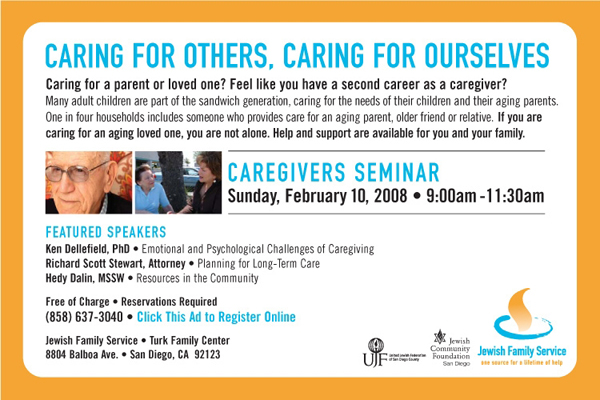
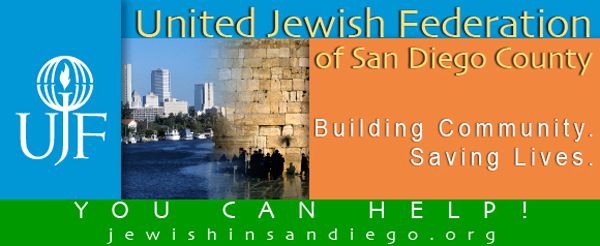

THE GREENE LINE
2 mothers experience tragedy, resilience
By Norman Greene
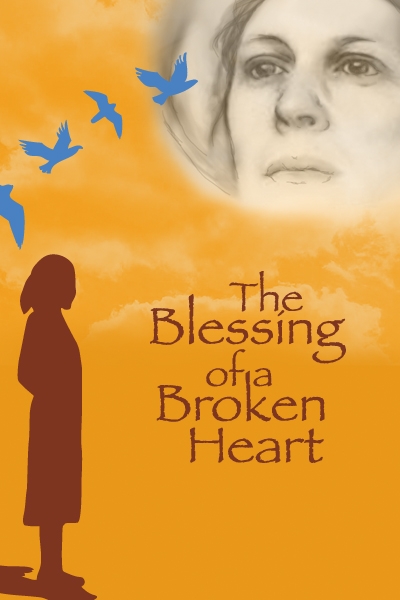 SAN DIEGO —Grieving and one’s relationship to God are both very personal, private matters. But both issues are being raised publicly this week by Author Sherri Mandell and San Diegan Linda Bennett. They are both grieving mothers who have lost a child to terrorism in Israel. SAN DIEGO —Grieving and one’s relationship to God are both very personal, private matters. But both issues are being raised publicly this week by Author Sherri Mandell and San Diegan Linda Bennett. They are both grieving mothers who have lost a child to terrorism in Israel.
The Blessing of a Broken Heart, a new play by Todd Salovey, based on Mandell’s book about the murder of her 13-year-old son Koby, is being presented at The San Diego Repertory’s Lyceum Space Theater at Horton Plaza. On Tuesday evening, the performance was followed by an interview with Linda Bennett whose daughter Marla was murdered at Hebrew University 5 ½ years ago.
The play is essential a moving monologue performed by a gifted actress, Lisa Robins. Miss Robins is ably assisted by Daniel Myers, playing her son Koby, and an ensemble of eight child actors as she portrays her upbringing, her marriage, her life in an Israeli settlement town, her children’s births, her son’s loss and her attempt to overcome her grief.
Mandell’s relationship to God is a major component in this play. She describes herself as growing up as a “cultural” Jew, never schooled in religious practice or ceremony. While experiencing Israel, she meets and marries a very observant fellow Jew. She struggles to accept the practices of Orthodoxy and to build a life in her adopted country, a country she clearly adores.
After the murder of her son, along with his childhood friend, in a historically spiritual cave in the dessert where the boys are found bludgeoned to death, Mandell must come to terms with her life, her grieving process and her relationship to God. It is a moving, 82 minute re-enactment by an actress who bears a striking physical resemblance to her character.
The children are very effectively used by director/playwright Todd Salovey, to emphasize the meaning and emotion of her words and color to her story. The set for this play in process is a simple spare one that uses background projections to place the audience at the scene.
At the conclusion of Tuesday night’s performance, Linda Bennett was interviewed on the stage by Director Salovey. She gave a synopsis of her daughter Marla’s life and achievements in her brief 24 years. She did so with a warmth, calm and great dignity.
Questions were welcomed from the audience that dealt with her reactions to her daughter’s murder, how she dealt with mourning, what was helpful to her and what was not, how she had decided to continue her life and to keep Marla’s memory alive. She noted that “I could have just stayed in bed with the covers drawn up over my face,” but this was not the path she chose. Instead, she and her family, husband, daughter and elderly mother, sought therapy. She joined a support group of mothers who have lost a child and she actively pursued ways to memorialize her lost child.
The Bennetts organized memorial funds to provide youth services in Israel and at home and have participated in numerous events that honor their gifted daughter’s memory. There are a long list of living tributes to Marla in Israel and in California. Linda Bennett has visited all of them and has returned to Israel twice since the tragedy. The couple has kept up a relationship with their daughter’s friends and with Marla’s boyfriend; they hope to attend his wedding one day.
Unlike Koby’s murders, The Bennetts have had the satisfaction of knowing that Marla’s killers were identified, tried and jailed for life. “I couldn’t dwell on a life of hate” she said, but noted that she was just as happy to know that her daughter’s assassins would never be freed. Koby’s killers have never been found.
Linda cherishes the letters and calls from around the world from people who knew and loved her daughter. In response to an audience question, she said that she had contacted families of the others slain that day by the explosion in the Hebrew University cafeteria.
When asked to compare her relationship with God, to contrast Mandell’s struggle, Bennett was to the point. “I love God,” she replied, “even though I can’t understand all of God’s actions.” However, she noted that her late mother, who recently passed away at the age of 99, refused to enter a synagogue after Marla’s death. Similarly, her husband has not been able to come to terms with the existence of a God that could allow the destruction of his beloved child.
Bennett noted that while she has been “out there” in the community, her husband has chosen to be more private. “We all grieve differently. It would have been too difficult for my husband to attend the play this evening,” she quietly stated.
Blessings of a Broken Heart is a poignant play that touches the hearts of anyone who has ever experienced loss. There is a sense of redemption in the knowledge that even a grief-stricken parent can go on, can learn to laugh again, can continue to experience the joys of living, while never forgetting the sorrows. In that sense, it was an uplifting evening in the theater.
Bennett will appear again tonight after the performance and Author Mandell will be interviewed by Director Salovey after the play’s performance on January 19th and 20th.
SAN DIEGO JEWISH WORLD THE WEEK IN REVIEW
Donald H. Harrison in San Diego: The Jewish Americans: 3-part PBS series offers 'history commenting on history'
Alexa Katz in San Diego: Into the Wild: A movie that delivers its title
Gaby Maio in San Diego: A ride into San Diego Jewish history
David Strom in San Diego: PTSD also affected survivors of the Shoah
Monday, January 14, 2008
Dov Burt Levy in Salem, Massachusetts: Jewish "angles" in the presidential primaries
J. Zel Lurie in Delray Beach, Florida: Did Bush have a vision or just a dream?
Norman Manson in San Diego: Dreams in Torah—where are they today?
Sheila Orysiek in San Diego: How Fiddler on the Roof keeps his balance
Sunday, January 13, 2008 (Vol. 2, No. 11)
Shoshana Bryen in Washington: Just what did Bush say in Israel?
Rabbi Baruch Lederman in San Diego: How our shortcomings can unite us
Rabbi Leonard Rosenthal in San Diego: Mitzvot easier done than other obligations
Ira Sharkansky in Jerusalem: Is Olmert only play acting for Bush
Friday-Saturday, January 11-12 (Vol. 2, No. 10)
Judy Lash Balint in Jerusalem: Bush security proved a tourist attraction
Bruce Kesler in Encinitas, California: Gandhi's grandson blames Jews for 'culture of violence' in the Middle East
Ira Sharkansky in Jerusalem: Baroque music lovers brave Bush security
Thursday, January 10, 2008 (Vol. 2, No. 9)
Judy Lash Balint in Jerusalem: Bush shuts down Jerusalem traffic
Shoshana Bryen in Washington, D.C.: Bush must make case for Iraq to Arabs
Donald H. Harrison in Coronado, California: Cecilia Kipperman is a Coronado legend
Bruce Kesler in Encinitas, California: President Bush should see Sderot
< BACK TO TOP
|
|

